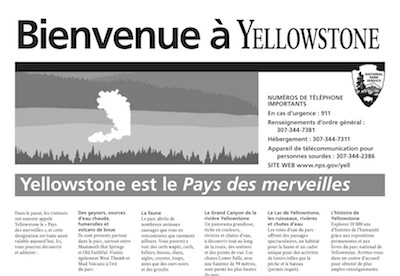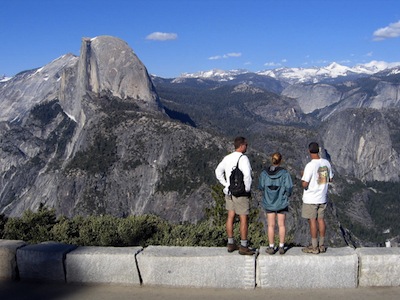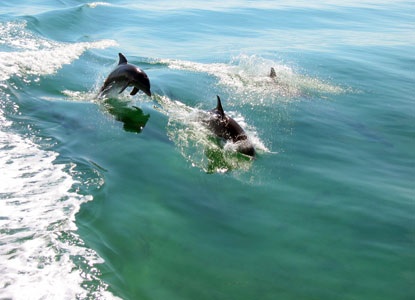
Foreigners face language barrier in parks
Throughout the year, there are foreign tourists that visit prestigious national parks around the nation.
The best part of visiting these magnificent parks is to experience the wonders one has never encountered. But what happens to those few visitors who cannot understand the displays or exhibits because they do not speak English?
Last year, there were 3.9 million visitors at Yosemite, park officials stated, and 20 percent of them were foreign visitors primarily from England, France, Holland, Japan, Germany, Australia, Spain, Ireland, Mexico, Switzerland and Canada.
| Click on the video at right to view an audio slide show about foreign tourists visiting the national parks by writer Lourdes Ortiz. |
“We do not offer any tour walks with our employed park rangers, especially to translate to different languages,” said Scott Gediman, public affairs officer for Yosemite National Park.
Even though they do not offer tours, they do offer brochures and basic maps in five major foreign languages – French, Italian, German, Japanese and Chinese. These are available at park’s entrances and at the Visitor Center.
According to Gediman, there are “two different tours to visit at Yosemite – Valley floor tour and Wawona tour.”
Foreigners can listen to the pre-recorded guide tapes during the Wawona tour. They have five language options to pick from at just a turn of a dial – English, Spanish, French, German and Japanese.
 |
Yellowstone’s brochure translated into French (Photo courtesy of the National Park Service). |
At Yellowstone National Park, abbreviated newspapers are provided that contain information about the numerous activities, places to go and safety tips. The newspaper is printed quarterly in four languages – Spanish, French, German and Mandarin.
“There are many foreign visitors that arrive with their own tour guide originated outside of the country, but we do not offer one here,” said Al Nash, chief of public affairs at Yellowstone National Park.
According to the Zion National Park spokesman Ronald Terry, Zion offers a general park newspaper to all tourists, which is a broad guide that enlightens visitors about the “services, programs, and safety information.” The newspaper is published quarterly and comes in four different languages – German, Spanish, Italian and French. Unfortunately, this park does not offer the regular basis tour programs in different languages.
| Tourists enjoy the view from Glacier Point at Yosemite National Park (Photo courtesy of Bethany Gediman). |  |
In the future, Terry and the rest of the rangers are working towards translating all the park’s orientation videos and AV presentations that educate future visitors about planning their visits. The videos also educate guests about the park’s history and about the programs in which they can participate.
The regular staff members at Zion have helped foreign visitors in the past because many of them are bilingual. The exhibits and displays are not translated in different languages, but they do hang signs asking the visitors to not feel the animals in languages other than English.
Approximately 4.5 million people visit the Grand Canyon National Park every year, and 30 to 40 percent of them are foreign tourists. Many foreigners carry their own commercial tours even though the park provides free commercial tour buses. The signage’s displayed all around the parks are standard pictorials so that everyone, no matter where they are from, can understand.
Grand Canyon’s publication, known as The Guide, is available for all guests. It features the latest information about attractions, restaurants and what to expect at the park. The Guide is also available at Grand Canyon’s Web site – http://www.nps.gov/grca/.
 |
Dolphins frolic during a glass-bottom boat tour at Biscayne National Park (Photo courtesy of the National Park Service). |
“Besides English, the park has about 2,000 publications in Chinese, French, German, Italian, Spanish, Japanese and Korean,” said Maureen Oltrogge, Grand Canyon public affairs officer.
Ninety percent of Biscayne National Park is underwater, which is why it is one of the largest marine park in the world. The best way to enjoy the park is by boat. Foreigners can experience the underwater world of fish and corals through glass-bottom boat tours or through snorkeling and dive trips.
“Boat tour programs are usually in English because we are dealing with the majority,” said Gary Bremen, Biscayne National Park ranger and spokesperson. “If we have mostly Spanish foreigners, we can make adjustments for them.”
Brochures are offered in Spanish, German, French and Japanese. They also have exhibits and films about the park in Spanish and Haitian Creole.
Enjoying the American outdoors and other park sites is not only intriguing and exhilarating for people around the nation, but also for visitors from around the world. The idea of translating brochures, map guides, newspapers and video presentations has and will continue to draw the attention of foreigners more and more each year.
For More Information:
- Contact Yosemite National Park, 9039 Village Dr., Yosemite National Park, CA 95389, at 209-372-0200 or visit http://www.nps.gov/yose/
- Contact Yellowstone National Park at 307-344-7381 or visit http://www.nps.gov/yell/
- Contact Zion National Park,145 Zion Park Blvd., Springdale, UT 84767, at 435-772-3256 or visit http://www.nps.gov/zion/
- Contact Grand Canyon National Park, Village Loop Road, Grand Canyon Village, AZ 86023, at 928-638-7769 or visit http://www.nps.gov/grca/
- Contact Biscayne National Park, 9700 SW 328th St., Homestead, FL 33033, at 305-230-7275 or visit http://www.nps.gov/bisc/

Comments are Closed